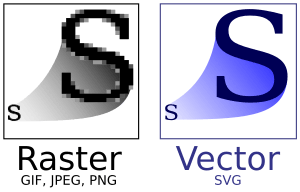Scalable Vector Graphics facts for kids
Scalable Vector Graphics (SVG) are a type of two dimensional picture that work on vectors, rather than pixels. This means that they can be easily be made bigger or smaller without losing any quality or becoming blurry. SVG is based on XML and created by the World Wide Web Consortium (W3C).
History
The W3C published SVG in September 2001. As of 2018 SVG is widely supported in all modern browsers.
The normal Filename extension is .svg and the MIME-Type is image/svg+xml.
Structure
SVG uses Extensible Markup Language (XML). So it has a definition of the document type.
<?xml version="1.0" encoding="utf-8"?>
<svg xmlns="http://www.w3.org/2000/svg"
xmlns:xlink="http://www.w3.org/1999/xlink" xmlns:ev="http://www.w3.org/2001/xml-events"
version="1.1" baseProfile="full"
width="800mm" height="600mm">
</svg>Difference between bitmap and vector images
This image shows the difference between bitmap and vector images. The vector image can be scaled forever, while the bitmap can not.
See also
 In Spanish: Gráficos vectoriales escalables para niños
In Spanish: Gráficos vectoriales escalables para niños

All content from Kiddle encyclopedia articles (including the article images and facts) can be freely used under Attribution-ShareAlike license, unless stated otherwise. Cite this article:
Scalable Vector Graphics Facts for Kids. Kiddle Encyclopedia.

